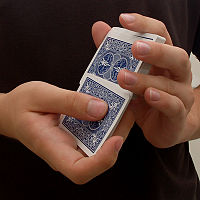1
Buy a Tarot Book and a Deck. Buy a Tarot deck that you like, and a book that will explain the interpretation of each of the 78 cards. If you are a novice reader, the Rider Waite deck is the most popular in the US and other decks often base themselves off it, so it's a good place to start. However, if there is a tarot deck that you are drawn to, then use that deck because it will channel your energy best to deliver the message.
2
Create a Relaxing Atmosphere. This is not only important to your guest, but to you as well. You will need to establish mutual respect with your guest (the questioner), and gather thoughts on the symbolism of the Tarot. The atmosphere ideally should be quiet, peaceful, and without distractions.
- It is important to get into the habit of creating the right mindset; however you do this, try to create a focus for your thoughts.
3
Ask the questioner to shuffle the cards. Some Tarot card decks can be quite large and awkward to shuffle; it doesn't matter how they are shuffled if your guest can't shuffle in their hands.
4
Ask the questioner to cut the cards. It is important that they are thinking about the question that they wish to ask while they do this.
5
Decide the spread that you will use. There are many different spreads which you can use, here are a few of the most common:
- Three card spread. Lay out three cards. Left to right, each card represents the Past, Present and Future.
- Five card Horseshoe spread. Lay out five cards in an upright arc. Left to right, each card represents the Present Position, the Present Desires, the Unexpected, the Immediate Future and the Outcome.
- Celtic Cross. Lay out ten cards as shown in the diagram to the right. Each one of the numbered cards represent the Questioner's:
- Present Position
- Immediate Influences
- Life
- Root of the Reading
- Past Influences
- Future Influences
- Feelings
- Outside Influences
- Hopes and Fears
- Outcome
6
Ask the questioner to choose a card for each position in the spread. Many Tarot practitioners have the questioner pick out and lay down the card, they do not touch the deck themselves.
7
Interpret the Cards. There are two sections within the Tarot deck, the Major Arcana and the Minor Arcana.
- Major Arcana. [1]. There are 22 of these cards. In some Tarot Decks, these are numbered, except the Fool. They represent different stages in life, different aspects of yourself, the situations you will encounter and the qualities you will need to help you.
- Minor Arcana.[2] There are 56 of these cards. They are divided into four suits with 14 cards in each, similar to normal playing cards. The suits are Cups, Wands, Pentacles and Swords, and each suit comprises of 10 numbered pipcards, and four court cards (Page, Knight, Queen and King).
- The Cups Suit (also known as the Chalice Suit) is linked with the standard Hearts Suit, and henceforth with your feelings and emotions, especially love, kindness and admiration. It is also associated with the classical element of Water.
- The Wands Suit (also known as the Staves Suit, Rods Suit or the Batons (the French word for Wands) Suit) is linked with the standard Clubs Suit, and with your intuition, especially vision, prediction and "gut-feelings". It is also associated with the classical element of Fire.
- The Pentacles Suit (also known as the Coins Suit) is linked with the standard Diamonds suit, and henceforth with the material world; your possessions and the things you cherish. It is also associated with the classical element of Earth.
- The Swords Suit is linked with the standard Spades Suit, and with your mind, especially your intellect and your decisions. It is also associated with the classical element of Air.



